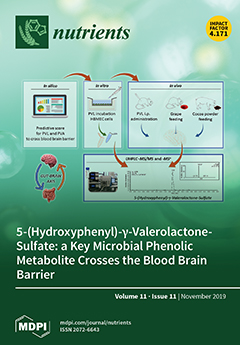Vegans are at an increased risk for certain micronutrient deficiencies, foremost of vitamin B
12. Little is known about the short-term effects of dietary change to plant-based nutrition on vitamin B
12 metabolism. Systemic biomarkers of vitamin B
12 status, namely, serum
[...] Read more.
Vegans are at an increased risk for certain micronutrient deficiencies, foremost of vitamin B
12. Little is known about the short-term effects of dietary change to plant-based nutrition on vitamin B
12 metabolism. Systemic biomarkers of vitamin B
12 status, namely, serum vitamin B
12 and holotranscobalamin, may respond quickly to a reduced intake of vitamin B
12. To test this hypothesis, 53 healthy omnivore subjects were randomized to a controlled unsupplemented vegan diet (VD,
n = 26) or meat-rich diet (MD,
n = 27) for 4 weeks. Vitamin B
12 status was examined by measurement of serum vitamin B
12, holotranscobalamin (holo-TC), methylmalonic acid (MMA) and total plasma homocysteine (tHcy). Holo-TC decreased significantly in the VD compared to the MD group after four weeks of intervention, whereas metabolites MMA and tHcy were unaffected. Body weight remained stable in both groups. VD intervention led to a significant reduction of cholesterol intake, and adequate profiles of nutrient and micronutrient status. Lower intake of vitamin B
12 was observed in VD, which was mirrored by a lower concentration of serum vitamin B
12 and reduced holo-TC after 4 weeks. Plasma holo-TC may be a fast-responding biomarker to monitor adequate supply of vitamin B
12 in plant-based individuals.
Full article






